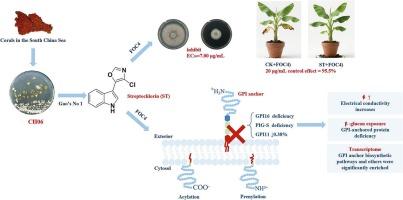The discovery of marine natural product Streptochlorin and its inhibition of Banana fusarium wilt by targeting the GPI pathway
IF 4
1区 农林科学
Q2 BIOCHEMISTRY & MOLECULAR BIOLOGY
引用次数: 0
Abstract
Marine actinomycetes represent a crucial reservoir of bioactive natural products, offering significant potential for developing green strategies in plant disease control. This study took Streptomyces CH06 isolated from corals in the South China Sea as the research object and systematically analyzed the antifungal mechanism of its metabolite Streptochlorin against Fusarium oxysporum f. sp. cubense Race4 (FOC4), the causative agent of banana Fusarium wilt. CH06 was identified via polyphasic taxonomy. Fermentation on Gao's No. 1 medium and LC-MS/NMR analysis yielded 10 metabolites, including novel nucleoside H7 and Streptochlorin (H5). Streptochlorin inhibited 10 phytopathogens by over 70 % at 13 μg/mL, and the EC₅₀ for FOC4 is 7 μg/mL. In the pot, Streptochlorin (20 μg/mL) achieved 95.5 % control of banana Fusarium wilt, surpassing carbendazim (89.9 %). Multi-omics analysis revealed that Streptochlorin disrupts fungal cell wall integrity by specifically inhibiting the glycosylphosphatidylinositol (GPI) targeting the GPI anchorprotein biosynthesis pathway (GPI11 protein abundance decreased to 38 % of the control). Phenotypic analyses confirmed increased membrane permeability (elevated extracellular conductivity), cell wall glucan exposure (Congo red staining), and hyphal surface blurring (TEM observations). This study for the first time elucidated the molecular mechanism by which Streptochlorin suppresses phytopathogenic fungi through targeting the GPI anchor protein biosynthesis pathway, providing novel insights for developing green fungicides derived from marine microorganisms.

海洋天然产物链氯素的发现及其对香蕉枯萎病GPI通路的抑制作用
海洋放线菌是具有生物活性的天然产物的重要储存库,为植物病害控制绿色策略的开发提供了巨大的潜力。本研究以南海珊瑚中分离的链霉菌CH06为研究对象,系统分析了其代谢产物链氯霉素对香蕉枯萎病病原菌Fusarium oxysporum f. sp. cubense Race4 (FOC4)的抑菌作用机制。通过多相分类学鉴定出CH06。在Gao's 1号培养基上发酵,LC-MS/NMR分析得到10种代谢物,包括新型核苷H7和链霉素(H5)。链霉素在13 μg/mL时抑制10种植物病原体70%以上,FOC4的EC₅0为7 μg/mL。在盆栽条件下,链霉素(20 μg/mL)对香蕉枯萎病的防效率为95.5%,超过多菌灵(89.9%)。多组学分析显示,Streptochlorin通过特异性抑制靶向GPI锚定蛋白生物合成途径的糖基磷脂酰肌醇(GPI)来破坏真菌细胞壁的完整性(GPI11蛋白丰度下降到对照组的38%)。表型分析证实膜通透性增加(细胞外电导率升高),细胞壁葡聚糖暴露(刚果红染色),菌丝表面模糊(透射电镜观察)。本研究首次阐明了链霉素通过靶向GPI锚定蛋白生物合成途径抑制植物病原真菌的分子机制,为开发源自海洋微生物的绿色杀菌剂提供了新的思路。
本文章由计算机程序翻译,如有差异,请以英文原文为准。
求助全文
约1分钟内获得全文
求助全文
来源期刊
CiteScore
7.00
自引率
8.50%
发文量
238
审稿时长
4.2 months
期刊介绍:
Pesticide Biochemistry and Physiology publishes original scientific articles pertaining to the mode of action of plant protection agents such as insecticides, fungicides, herbicides, and similar compounds, including nonlethal pest control agents, biosynthesis of pheromones, hormones, and plant resistance agents. Manuscripts may include a biochemical, physiological, or molecular study for an understanding of comparative toxicology or selective toxicity of both target and nontarget organisms. Particular interest will be given to studies on the molecular biology of pest control, toxicology, and pesticide resistance.
Research Areas Emphasized Include the Biochemistry and Physiology of:
• Comparative toxicity
• Mode of action
• Pathophysiology
• Plant growth regulators
• Resistance
• Other effects of pesticides on both parasites and hosts.

 求助内容:
求助内容: 应助结果提醒方式:
应助结果提醒方式:


